Galactic
Large Scale Galactic Emission
Most of the observations which have been performed with Cos-B have been devoted to the study of the galactic disc. A detailed and complete contour map of the galaxy seen in the light of gamma radiation is shown in figure 1.
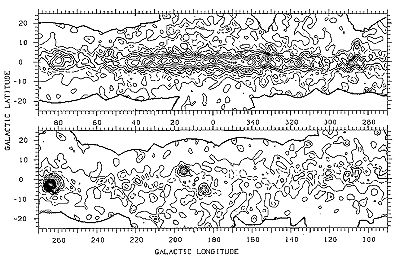 |
|
Figure 1: Galactic gamma ray map (150-300 MeV) derived from the final COS-B database and provided with it. |
It has been derived from merging the data from all the low latitude observations in the final Cos-B database. Factors for changes in sensitivity have been incorporated in producing the map, which is based on about 200 000 gamma-ray events.
The presentation here is somewhat smoothed: a 150-300 MeV energy band is chosen to show the clumpiness of the data corresponding to identified and candidate sources.
The picture reveals galactic features of many scale sizes:
- Centre, width of emission unresolved
- Peak of emission follows galactic plane
- Arms and interarm regions
- Local emission out to mid latitudes (Perseus arm)
- The Vela source
- The anti-centre sources Other hot-spots (sources) in plane
These qualitative findings have been substantiated by quantitative correlation's in which the gamma-ray emission is predicted from models of cosmic ray bombardment of interstellar gas. The important gas data required to do this properly has only recently become available from Wco/12CO observations of molecular hydrogen.
The observed galactic emission I(g) may be modelled by 3 components:
I(g) = (q(g)/4Pi) [ N(H1) +2N(H2)] + I(b)
where
q(g) = Gamma ray emissivity / atom
N(H1) = H1 gas distribution (convolved)
N(H2) = CO/H2 distribution (convolved, new surveys)
I(b) = Background
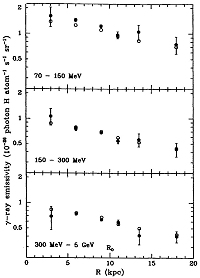 |
|
Figure 2: Galactocentric distribution of the gamma-ray emmisivity obtained from a correlation of HI, CO and gamma-ray data. |
Furthermore, as summarised by Bloemen (Ref.17) the model may be enhanced by considering not only the mass of gas but also its distance (as determined from its Doppler shift under a given model of the rotation of the galaxy). This may then be fitted with the observed gamma-ray emission by peeling off the measured H1 and H2 emission into different volumes of origin. The Cos-B team has thereby correlated the observed gamma-ray emission with the hydrogen in six galactocentric annular rings. The data have been analysed to yield the gamma-ray emissivity values in the six galactocentric distance bands, and in three energy ranges.
The result is shown in figure 2 taken from Bloemen (Ref.17) which presents evidence for a radial gradient of both cosmic-ray electrons i.e. those responsible for the bulk of the low-energy part of the gamma-ray emission, and nucleonic cosmic-rays. A proton gradient is seen to exist, though weaker than the electron one. This has moderated earlier claims (Ref.18) that the nucleonic cosmic rays may extend beyond our own galaxy.
Further evidence that gamma-rays trace the distribution of matter in the galaxy has resulted from the large-scale correlation of intermediate latitude gamma rays with the total gas column as derived from galaxy counts (Ref.19). The gamma-ray emissivity derived from this method is locally in excellent agreement with that given by the comprehensive, low latitude galactic analysis of Strong et al. (Ref.20).
Binary Systems
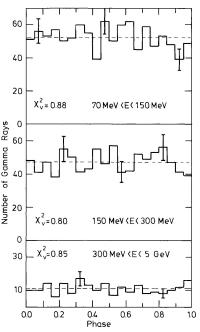 |
|
Figure 3: The phase histograms of arrival times of gamma rays in a small field centred on Cygnus X-3 using data from 7 COS-B observations. |
Cos-B devoted a significant fraction of its lifetime to the search for emission from Cygnus X-3, the 4.8h X-ray pulsar and possible UHE gamma-ray emitter. Cygnus X-3 was reported to have been seen pulsating in 100 MeV gamma rays by SAS 2 in 1972 (ref.15). Despite devoting about 300 days (in excess of 10% of the entire mission) at several epochs to viewing Cygnus X-3, no point-like emission was observed and no 4.8 hr gamma variability of the field was detected, as shown in the combined data (ref.16) in Figure 3. To avoid a conflict with the SAS 2 data it can only be concluded that the emission is time variable, having turned off prior to the launch of Cos-B.
Her X-1 and Vela X-1 are two systems which are believed to emit UHE gamma rays. Her X-1 could not be viewed by Cos-B but Vela X-1 appeared many times in the field of view. However, no gamma ray signal, pulsed or otherwise, could be detected from this field.
Localised Gamma-Ray Sources
Only a handful of the 2CG catalogue of sources are identified: two being pulsars, one a quasar and one a molecular cloud complex. It is already demonstrated that molecular hydrogen concentrations produce localised emission so recent studies have taken the distribution of this gas into account in refining the source search methods. Two groups have made independent analyses of the Cos-B data in searching for sources. Simpson and Mayer-Hasselwander (Ref.21) used a bootstrap sampling method to test for the reality of already postulated sources and to search for new sources while the Leiden/EXOSAT group (Pollock et al. (Ref.22) and private communication) uses a maximum-likelihook method to test for the existence of point-like emission in the entire data.
It has become evident that if the background is modelled more precisely a significant number of the sources of the 2CG catalogue disappear and can be explained by the presence of known amounts of gas. While the MPE group goes as far as suggesting new sources (or unexplained excesses) the Leiden/EXOSAT analysis does not throw up new source candidates. It is hoped that the work on the definitive Cos-B catalogue can soon be concluded so that it may be of use in establishing viewing programmes of future high energy astronomy missions like GRO and Sigma.
With only 2CG184-05 and 2CG263-02 unequivocally identified with PSR0531+21 and PSR0833-45, what of the bright source Geminga?
Geminga, or 2CG195+4 is one of the brightest sources in the 2CG catalogue. First discovered by SAS2, the source stands out brightly in a low background region of the galactic disc. As a consequence of the favourable signal to noise, an accurate spectrum has been determined (as shown in figure 4).
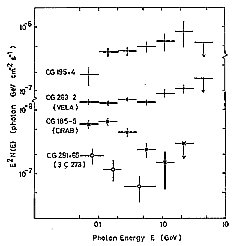 |
|
Figure 4: COS-B energy spectrum of CG195+4 (Geminga) shown for comparison with that of the Crab and Vela pulsar and 3C273. |
The relatively hard spectrum yields a high gamma-ray count at high energies and this has enabled the position to be estimated with the highest precision of all the catalogued sources (error circle ~0.25 deg). This error is of the same magnitude as the attitude error of Cos-B, so further improvement cannot be achieved.
Despite its existence being known for about 15 years it remains unidentified. Numerous searches have been made with optical, UV, IR, radio and X-ray telescopes and very many candidates have been offered. For instance, an X-ray object observed using both the Einstein and EXOSAT observatories was thought a highly likely candidate by Bignami (Ref.23) but follow-up observations in the IR and the optical have only served to fire further controversy. Suggestions thus range from an extremely nearby object (<200pc) to a gamma-ray bright quasar observed within the error box with the Effelsburg radio telescope; leaving Geminga one of the big mysteries of high energy astrophysics.
Gamma-Ray Pulsars
Amongst the earliest celestial objects to be studied by Cos-B were the radio pulsars PSR0531+21 (Crab) and PSR0833-45 (Vela) and both have been observed several times:
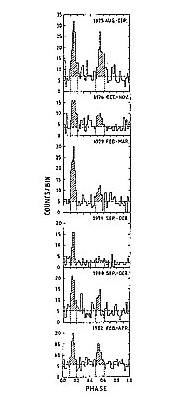 |
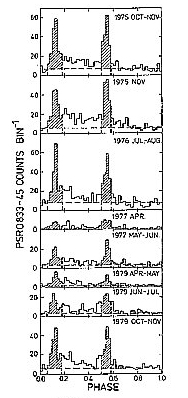 |
|
Figure 5: Gamma-ray light curves of PSR0531+21 at 6 COS-B epochs |
Figure 6: The gamma-ray light curves of PSR0833-45 at 8 COS-B epochs |
The Crab is seen at six epochs (figure 5) and Vela at eight (figure 6) and, not shown, those in April-June 1981.
A major discovery resulted from comparing the light curves of the Vela and Crab pulsars for the different epochs. It is seen that while during several years the light curve of Vela remains unchanged the Crab's light curve varies. The strong pulse at phase 0.55 in the 1975 August observations is barely seen in the later observations (Ref.8). Meanwhile the light curve of the X-rays as measured on board Cos-B stayed rock-steady.
The last task of Cos-B was to view the anticentre region for an extended period of time. This observation was important to determine whether the light curve change had persisted and also to assess sensitivity changes which had occurred throughout the mission. The April 1982 light curve shows again the familiar strong double peak structure seen at the beginning of the mission and using the final sensitivity corrections Clear et al. (Ref.9) quantitatively confirm the Crab variability.
For Vela, Grenier et al. (Ref.10) find evidence for a change in intensity in the emission which seems to succeed a glitch in the period. Their detailed analysis also unearthed spectral dependencies of the light curve.
The differences in behaviour between these two ostensibly similar objects continue to accrue: recall that the first major surprise was the difference between the phases of the radio- and gamma-pulses already detectable in the data of SAS 2 (Ref.11) and subsequently confirmed by Cos-B (Ref.12).
A search for evidence of pulsed gamma-ray emission from the other known radio pulsars has proved fruitless. Because of the low rate of accumulation of gamma-ray events, it is necessary to fold the data from a whole month's observation with periods of the order of milliseconds. Accurate knowledge is requird of the pulsar period P and also of its derivative Pdot. Although published data were available for many of the 330 or so known radio pulsars, most of these require extrapolations of up to 5 years to the epoch of the Cos-B observations. In only a fraction of the cases is the extrapolated uncertainty in the parameters small enough to avoid smearing of the light curve. A study of over 100 such pulsars in the field of view of Cos-B yielded none for which there was any indication of pulsed emission above the 2 sigma level of confidence (Ref.13).
Young pulsars like Crab and Vela may still contribute significantly to the galactic emission but those young pulsars so far known are not bright gamma-ray sources and it must be borne in mind that intrinsically the Crab and Vela sources are quite low in luminosity compared with the sources of the Cos-B catalogue. Indeed Vela (at 500pc) would not have been visible had it been at the typical distance of a 2CG catalogue source (2-7kpc). Nevertheless searches for millisecond pulsars were attempted to no avail. A search for the recently discovered fast pulsar (Ref.14) in CTB80 (period 39.53 ms) was possible given the accuracies in P and Pdot. Data from four observations were analysed and no consistent signal was present in the data.
It looks unlikely that further retrospective searches will be feasible given the stringent requirements on P and Pdot in extrapolating to the Cos-B epoch.
Resolved Galactic Sources
Later observations added to the database support the theory that the source 2CG353+16 is the Rho Ophiuchi cloud complex. In the combined data the cloud complex has become resolved and is no longer considered a point-source. The production mechanism for gamma-ray emission is cosmic-ray bombardment of gas in the cloud complex 190pc away, although predictions differ slightly (by about a factor of 2) with the observations (ref.6).
This conclusion is complementary with the observation of gamma-rays from the Orion nebula by Cos-B. The gamma-ray intensity agrees very well with predictions modelled on latest available HI, HII and H2 data under the assumption of local cosmic ray flux (ref.7).
